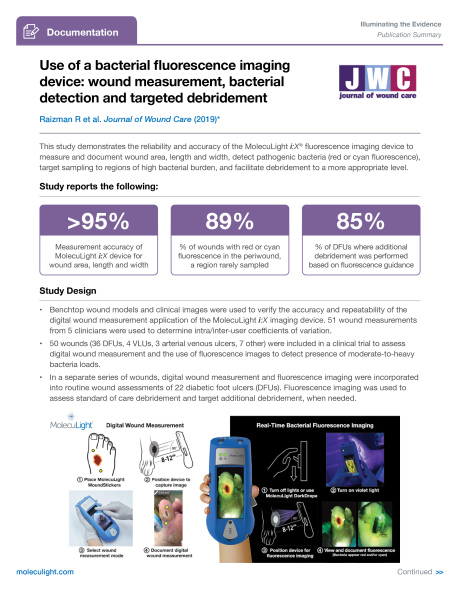Objective: Diagnostics which provide objective information to facilitate evidence-based treatment decisions could improve the chance of wound healing. Accurate wound measurements, objective bacterial assessment, and the regular, consistent tracking of these parameters are important aspects of wound care. This study aimed to assess the accuracy, clinical incorporation and documentation capabilities of a handheld bacterial fluorescence imaging device (MolecuLight i:X). Method: Benchtop wound models with known dimensions and clinical wound images were repeatedly measured by trained clinicians to quantify accuracy and intra/inter-user coefficients of variation (COV) of the imaging device measurement software. In a clinical trial of 50 wounds, wound dimensions were digitally measured and fluorescence images were acquired to assess for the presence of bacteria at moderate-to-heavy loads. Finally, fluorescence imaging was implemented into the routine assessment of 22 routine diabetic foot ulcers (DFU) to determine appropriate debridement level and location based on bacterial fluorescence signals. Results: Wound measurement accuracy was >95% (COV <3%). In the clinical trial of 50 wounds, 72% of study wounds demonstrated positive bacterial fluorescence signals. Levine sampling of wounds was found to under-report bacterial loads relative to fluorescence-guided curettage samples. Furthermore, fluorescence documentation of bacterial presence and location(s) resulted in more aggressive, fluorescence-targeted debridement in 17/20 DFUs after standard of care debridement failed to eliminate bacterial fluorescence in 100% of DFU debridements. Conclusion: The bacterial fluorescence imaging device can be readily implemented for objective, evidenced-based wound assessment and documentation at the bedside. Bedside localisation of regions with moderate-to-heavy bacterial loads facilitated improved sampling, debridement targeting and improved wound bed preparation.
Back to All Clinical Evidence
Digital Wound Measurement, Chronic Wounds
Bacterial fluorescence imaging for wound measurement, bacteria detection and targeted debridement
>95% measurement accuracy of MolecuLight i:X device for wound area, length and width
89% of wounds with red or cyan fluorescence in the periwound, a region rarely sampled
85% of DFUs where additional debridement was performed based on fluorescence guidance











